Category: Internet Art & Culture
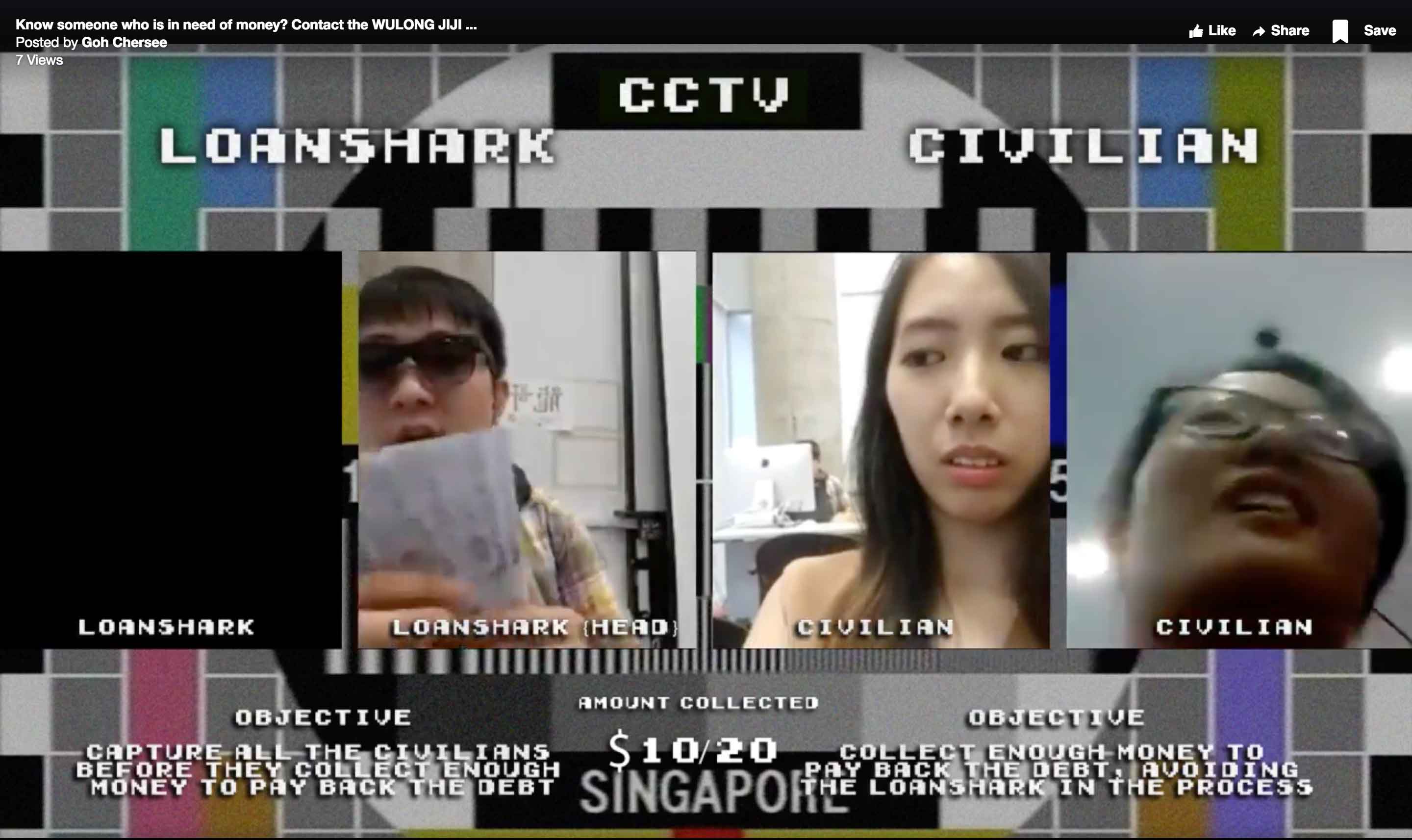
Final Broadcasting: O$P$
Title:
Know someone who is in need of money? Contact the WULONG JIJI GAOGAO PTE. LTD. right now. Help is always available.
Description:
Our broadcast is about two civilians that owe a huge amount of money to an infamous loan shark organisation, Wu Long. The duo had to find enough money around the place so that they could pay the head of the loan shark organisation the total amount of money they had borrowed from him. The debtors had a buffer time of about 5 minutes to collect as much money as they could or hide, after which the loan sharks would start chasing them down. Will the debtors be able to collect enough money before the time run out?
In the live stream, Cher See and Xin Feng were role playing as the infamous loan sharks while Joan and Hannah were role playing as the civilians. The civilians’ mission was to locate all the hidden envelopes that contain money, finding every possible areas that had the hidden stash of money. The head of the loan shark, Long Ge (aka Cher See) had dispatched an underling, Ah Feng (aka Xin Feng) to find the two civilians to pressure them to pay back the money they owe. Joan managed to find the envelopes hidden around the area but was caught by Ah Feng shortly after she found the third envelope. She was brought to Long Ge to check on the amount of money she had collected. Joan had to wait for Hannah to find the remaining amount of money that was escalating every 10 mins. On the other hand, Hannah had to go around and beg people for money so that she could pay back her debts while finding ways to escape the loan sharks. After finding enough money, Joan asked Hannah to come find Long Ge to return back the remaining sum. In the end, both civilians were able to pay back what they had borrowed from the loan sharks.
Hannah & Joan live broadcast:
Know someone who is in need of money? Contact the WULONG JIJI GAOGAO PTE. LTD. right now. Help is always available. (a video stream about two debtors on the road to repaying their debts to a infamous loan shark organisation)
Posted by Joan Li on Wednesday, 15 November 2017
Know someone who is in need of money? Contact the WULONG JIJI GAOGAO PTE. LTD. right now. Help is always available. (a video stream about two debtors on the road to repaying their debts to a infamous loan shark organisation)
Posted by Joan Li on Wednesday, 15 November 2017
Cher See & Xin Feng live broadcast:
Know someone who is in need of money? Contact the WULONG JIJI GAOGAO PTE. LTD. right now. Help is always available. (a video stream about two debtors on the road to repaying their debts to a infamous loan shark organisation)
Posted by Xin Feng on Wednesday, 15 November 2017
Combine broadcast:
Part 1:
Know someone who is in need of money? Contact the WULONG JIJI …
a video stream about two debtors on the road to repaying their debts to a infamous loan shark organisation
Posted by Goh Chersee on Wednesday, 15 November 2017
Part 2:
Know someone who is in need of money? Contact the WULONG JIJI …
a video stream about two debtors on the road to repaying their debts to a infamous loan shark organisation (PART 2)
Posted by Goh Chersee on Wednesday, 15 November 2017
Part 3:
Know someone who is in need of money? Contact the WULONG JIJI …
a video stream about two debtors on the road to repaying their debts to a infamous loan shark organisation (Part 03)
Posted by Goh Chersee on Wednesday, 15 November 2017
Where all the remaining money are:
Know someone who is in need of money? Contact the WULONG JIJI GAOGAO PTE. LTD. right now. Help is always available. (a video stream about two debtors on the road to repaying their debts to a infamous loan shark organisation)
Posted by Xin Feng on Wednesday, 15 November 2017
Further Improvements:
The one major problem that the team faces were the internet connection. It was causing lagginess and disconnection when the team were co-broadcasting. However, the team had came to believe that such limitation were actually working in our favor as it created a more interesting composition and dynamics when things were not working as it should have. There were some shots that were quite unusual and could really sell the narrative that the two civilian were actually running away from the loanshark. Nonetheless, the team were still able to complete the project on time even when the internet connection were poor.
Another problem that we could have improved on were the balancing of the game. There were some envelope that were hidden in areas that were too difficult to find and some that were too obvious. Perhap the team could strike a balance if we had another chance to improve on our live stream. However, placing envelops at places that requires strenuous effort to locate promote our team members to interact with passersby, borrowing money and help from them. It remove the stagnancy of our co-broadcasting and introduce new elements to keep the audiences entertain in our stream.
Overview:
In the live stream, I contributed by acted as one of the debtors who co-broadcasted with the other debtor, Joan. I had to fully express myself but sometimes I get caught up with my surroundings and forgot that I was broadcasting. I had portray my usual self. The role play I did implemented with the whole idea of loan shark and debtors. The overall piece was able to come together when all of us played our roles well and did what we were suppose to do. As a debtor I had to find my way around the location so as to either find envelopes or asking the passerby for help.
The collaboration among the team was great. We discussed the ideas we had and decided on one, process of how the live stream should flow, what the narrative should be and changed it accordingly so that it would fit our theme of hide and seek. We had to make a few changes along the way and the biggest change we did was to scrape the police and thief idea since it did not plan out as we had intended to. We had missing elements as to why the thieves we being chased by the police and why there was a need to find clues while solving riddles. The team decided to change it but still stick to the hide and seek theme hence coming out with our final broadcast, loan shark and debtors.
Personally I was super fascinated by Hole in Space where people from different locations could communicate together via the third space which I am currently doing throughout the broadcasting while collaborating with people. Through the collaborative broadcast through adobe connect or OBS, I get to see myself live with the other person. Now the idea of communication via the third space is happening once we could co-broadcast via Facebook live and seeing the environment I am in and the other person. Later seeing it through the screen.
“A visionary premise … the lines between imagination and reality were blurred almost to distinction”
LOS ANGELES HERALD EXAMINER, Elaine Warren
I feel that through the constant broadcasting it resulted in what Elaine Warren had mentioned. I was integrating imagination and reality together which causes the lines between the both to be blurred and I resulting in myself forgetting that I was on live stream. Even in the recent telematic stroll, I had forgotten about being online but rather I did whatever I thought it was normal and became more comfortable with it. I even had conversations with my father who was at home and watched TV as if it was normal.
I believe that if Kit Galloway and Sherrie Rabinowitz were to witness the live streams we had, they would be so glad that we are actually doing the co-broadcasting in the third space. Having to see the collective narrative unfolding through every single broadcast seems more and more amazing.
The other artist I am impressed is Second Front. They were so crazy about breaking the norm and creating such great pieces that led to performances in the virtual space. The use of avatar to create performance art what something that amazed me and I have wanted to explore on that area. It seems that anything the Second Front could do they would be the first one to jump in to try it. I feel that it was challenging yet courageous to take on such an act.
“Imagination is the only limitations towards performance.”
Bibbe Hansen
The most inspirational quote was from Bibbe Hansen when she mentioned the above quote. It had never once struck me that imagination was the only thing that limits what I can do in the virtual space but once she mentioned that I immediately had a lightbulb moment. It made perfect sense since it is performance art we are discussing about.
Their works had inspired me in terms of the final project but instead of creating avatars I feel that I am the avatar in the virtual space. Having the whole live stream unscripted created a freedom in the things we talked about. It seems that the final project that the team had done seems like a performance art piece while incorporating the aspects of a game environment. Like the Second Front, we also had our own currency and tried to play around with that. I had fun in my final project.
Overall, I felt that the final project and the contribution to the project made me became more relax on social broadcasting. Through the exploration of Hole in Space and Second Front, it made me feel that there are more exciting ways to create social broadcasting. I can see what others are doing via their live stream and viewing everything together seems as though I am there and participating as an avatar. It had been an exciting time and changed my view on social broadcasting.
Telematic Stroll with Joan
Part 1:
Telematic stroll – Neighborhood and going home
Posted by Joan Li on Monday, 6 November 2017
Part 2:
Telematic Stroll – Neighborhood and going home (cont.)
Posted by Joan Li on Monday, 6 November 2017
I collaborated with Joan in this telematic stroll project. It was quite an experience having to do things simultaneously and having to synchronise with each other. Usually having people doing things together on the first space is quite challenging since everyone is just so busy in their lives. Coming together to do things together in the third space is even more challenging since we had to synchronise without any practice at all.
There is 2 parts to the video because my phone died half way through the live feed. It was my fault as I did not check my phone’s battery before going live. I have learnt that all times I need to make sure my phone is fully charge so that when through a live feed (which drains lots of my battery especially using data) I would not have disappeared halfway through. Having said that, the experience of filming the east and the west side of Singapore was quite interesting since we get to see different side of Singapore HDB and also our house. It was as if we are in the same house doing the same thing at the same time. Even though there was hiccups and technical problems when we were doing the live video on Facebook, I enjoyed the process.
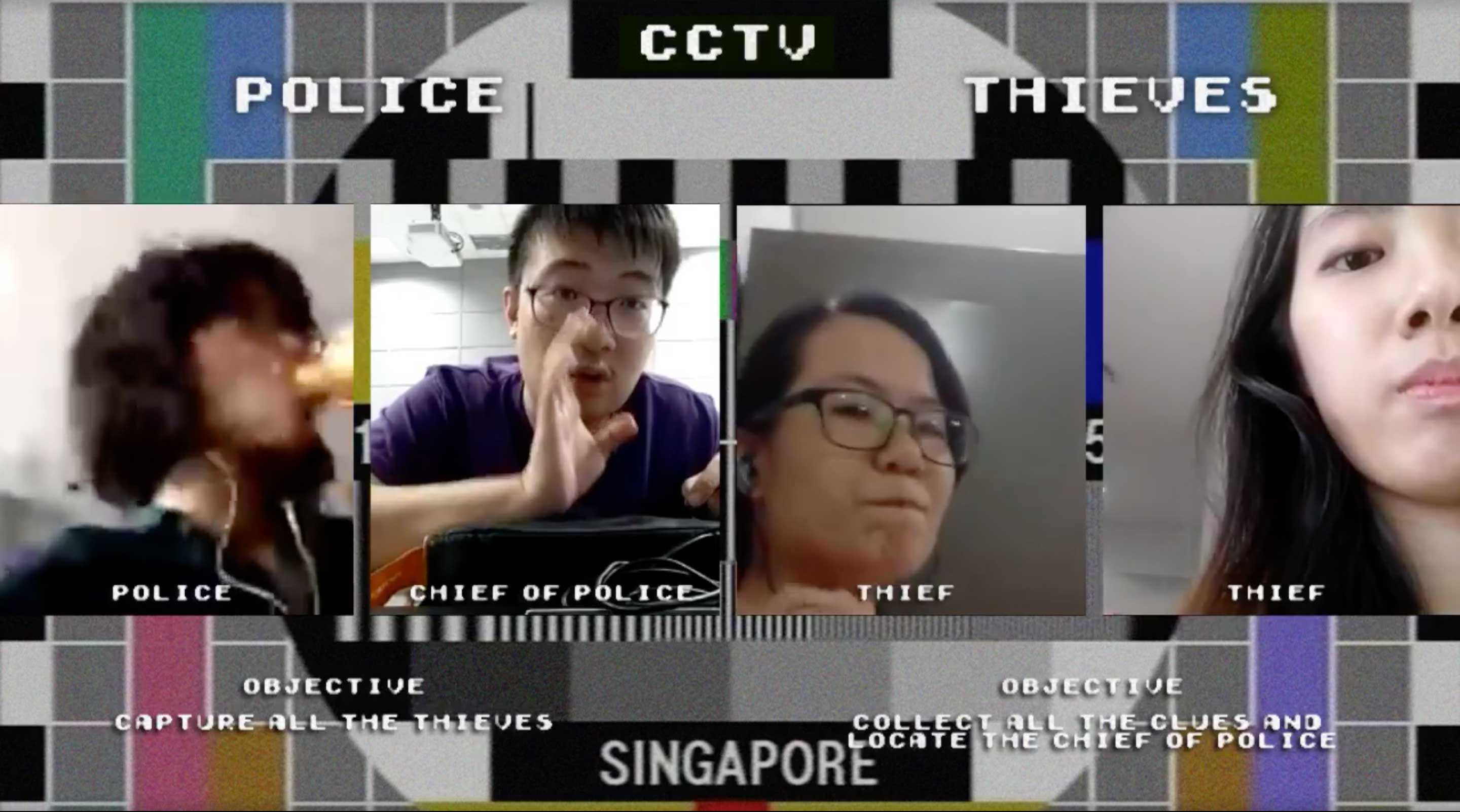
Final Co-broadcasting technical test 2
Technical test
Posted by Goh Chersee on Wednesday, 1 November 2017
Posted by Xin Feng on Wednesday, 1 November 2017
Technical test 2
Posted by Hannah Kwah on Wednesday, 1 November 2017

Research Critique: Second Front Interview on Networked Conversations
The interview with the Second Front members were exciting and inspirational. They have set me thinking about performance art and their approach or opinions on it. It is so fascinating to see them getting so excited when they crash the internet. Usually when the internet crashes, people start to panic and try to fix the problem asap. Through their reaction, it made me think through how I could approach the similar matter if my internet crashes or lost of internet connectivity instead of getting all panic.
Second Front based their experience in theatre performances into the virtual space where they could do anything. In the world of possibilities, many may feel that Second Life would be more interesting since they could go wild in whatever they do as compared with their First Life or personal life. The audiences they have are actively participating in the performance they create however in some instances, they target passive-in-world audiences. It is interesting that having been around for many years, their audiences are still highly active. The link shows the amount of audiences that have participated/ watch their performances.
https://arstechnica.com/gaming/2017/10/returning-to-second-life/
“Imagination is the only limitations towards performance.”
Bibbe Hansen
It is interesting that they feel the only thing limiting their performance is their imagination mentioned by Bibbe Hansen. Usually we see our surroundings or environment as our limitations but drawing the fact that imagination is the factor. I guess in their case the need to have limitless imagination is the key to constantly create interesting performances.
“Based on what happens…”
Patrick Lichty
Their works are mainly based on happenings where they played with identities. Second Front steal their audiences identities or making the participants as an avatar without them knowing. In such cases, some are scripted while others are not. It brings the question as to when they decide when it is scripted and when it should be spontaneous. They agree that it depends on the intention of the artist and director, what they want to portray on and their targeted audiences. For Grand Theft Avatar it is a heavily scripted narrative whereas Summer of Love 2.0 and Car Bibbe is spontaneous since the focus is on happenings and events.
“As technology evolves without any boundaries… rewiring our brain in technology” is what Liz Solo mentioned in the interview with Second Front. It seems they are progressing further in their experimentations with incorporating various technology with their performance just as Patrick Lichty said. It is interesting that they are already using various platforms, google docs, odyssey art and performance simulator to create their performance personally or for audience. The exploration of world based performance to virtual space is happening currently in their works now.
“Connected with others using tools, immersive, digital culture with 2 foot in”
Doug Jarvis
Collaboration is a huge factor in their performance. Doug Jarvis mentioned in the interview where connecting with other enables him to interact with people all over the world. Since Second Front members are located all over the world, it makes sense that the digital platform is needed for collaborative work. Just as Kit Galloway and Sherrie Rabinowitz, creators of Hole in Space mentioned that “…create a performance place with no geographical boundaries…” and here Second Front is also demonstrating the same fact. Just as Hole in Space interacts with the audiences through the use of first and second space creating a third space, Second Front also interacts with their audiences in the same manner.
Overall, the interview with the Second Front members created lots of thinking and made me think of how many times I wanted to separate the virtual and reality. At the same time both realms also portrays me just through a different manner. When performance art push the boundaries, the bodily aspect is not always necessary but the emotions that we have can also be portrayed through an avatar too. I wish that one day I could collaborate with the Second Front members which I could learn from them their performance art vision.
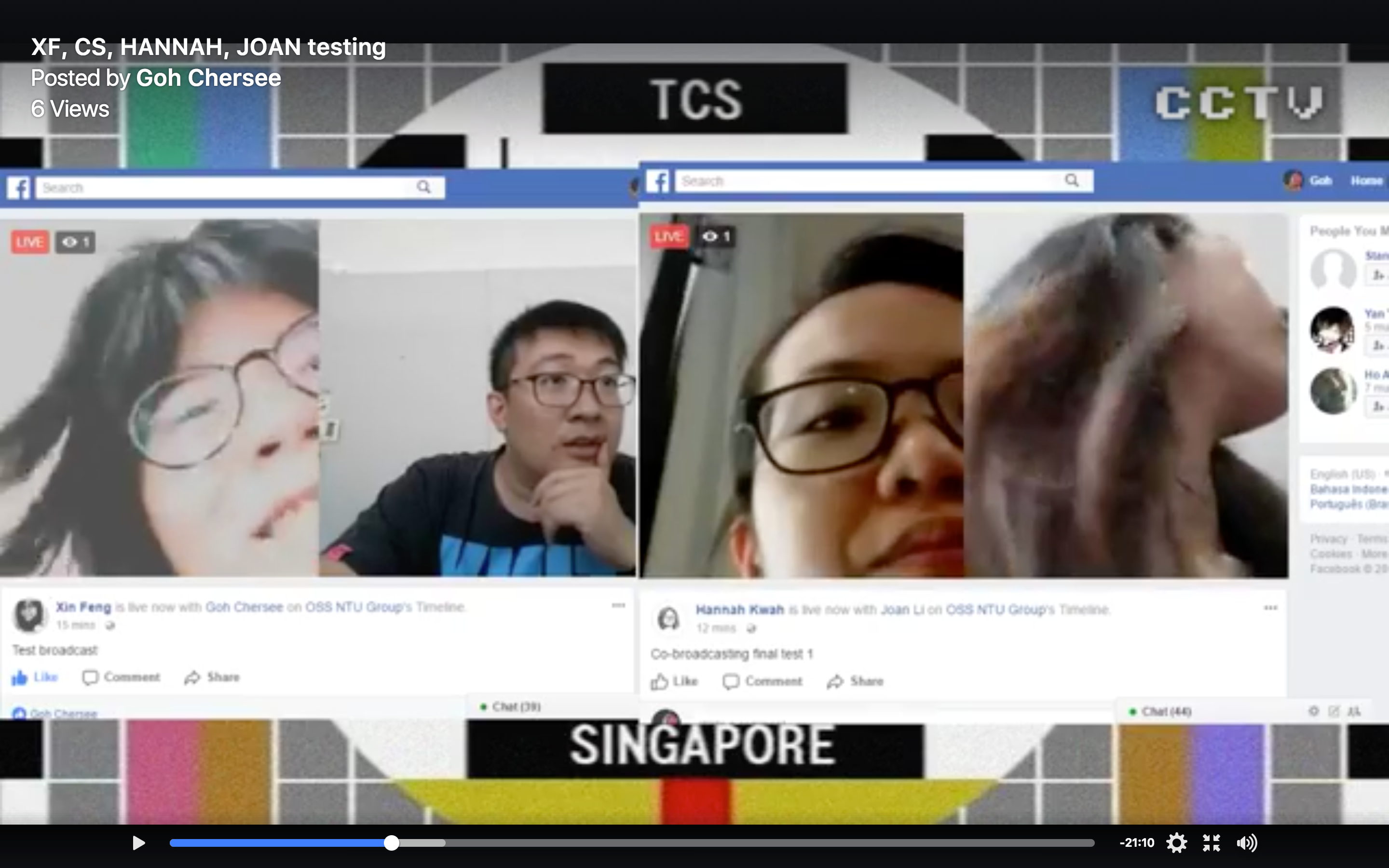
Final Co-broadcasting Test 1
Hannah & Joan live broadcast
Co-broadcasting final test 1
Posted by Hannah Kwah on Tuesday, 24 October 2017
Cher See & Xin Feng live broadcast
Test broadcast
Posted by Xin Feng on Tuesday, 24 October 2017
Combine broadcast
Posted by Goh Chersee on Tuesday, 24 October 2017
Roles: Cher See (Police), Xin Feng (Police), Hannah (Thief), Joan (Thief)
Co-broadcasting reflections:
One of the technical difficulties that we face while we were broadcasting was the lagginess of our stream. We kept on disconnecting with each other and the constant need to stay connected to the internet had therefore limiting our hiding spot. The problem was that our stream requires a certain level of responsiveness. The time delay between all of the live feed might cause confusion and disarray in our communications with one another.
The audio quality was surprisingly loud and clear and the vocal communication between the co-broadcasters was smooth. At the beginning of the broadcast, we were all in the same room and the echo of audio transferred between the five devices was very interesting. The close proximity of the devices also created some audio feedback. At around 00:13 & 24:00, we experimented with this echo and feedback effect.
As the race started, the thieves headed off to various hiding spots and were able to converse easily through the broadcast. We also noted that the clear audio recording allowed the policemen to eavesdrop easily on the thieves’ conversation and deduce their locations. The comment section for Joan and Hannah live feed was smooth and did not run into any problems. Cher See(police) have posted some riddles for the Thief team to guess.
Future Improvements:
For the thieves, we could improve on our camera angle and reveal more of our locations so that it would create interesting footages. It would also allow the policemen to have a better idea and better regulate the race.
As for the riddles given by the policeman in the headquarters, if the thieves are unable to guess it another riddle will be given. If the latter are able to solve it, the policemen will reveal one of the numbers of the padlock.Maybe the police could change position with each other so that the police team would not tire themselves.
We could also add in special effects, sound effects and make our combine stream more aesthetically pleasing.
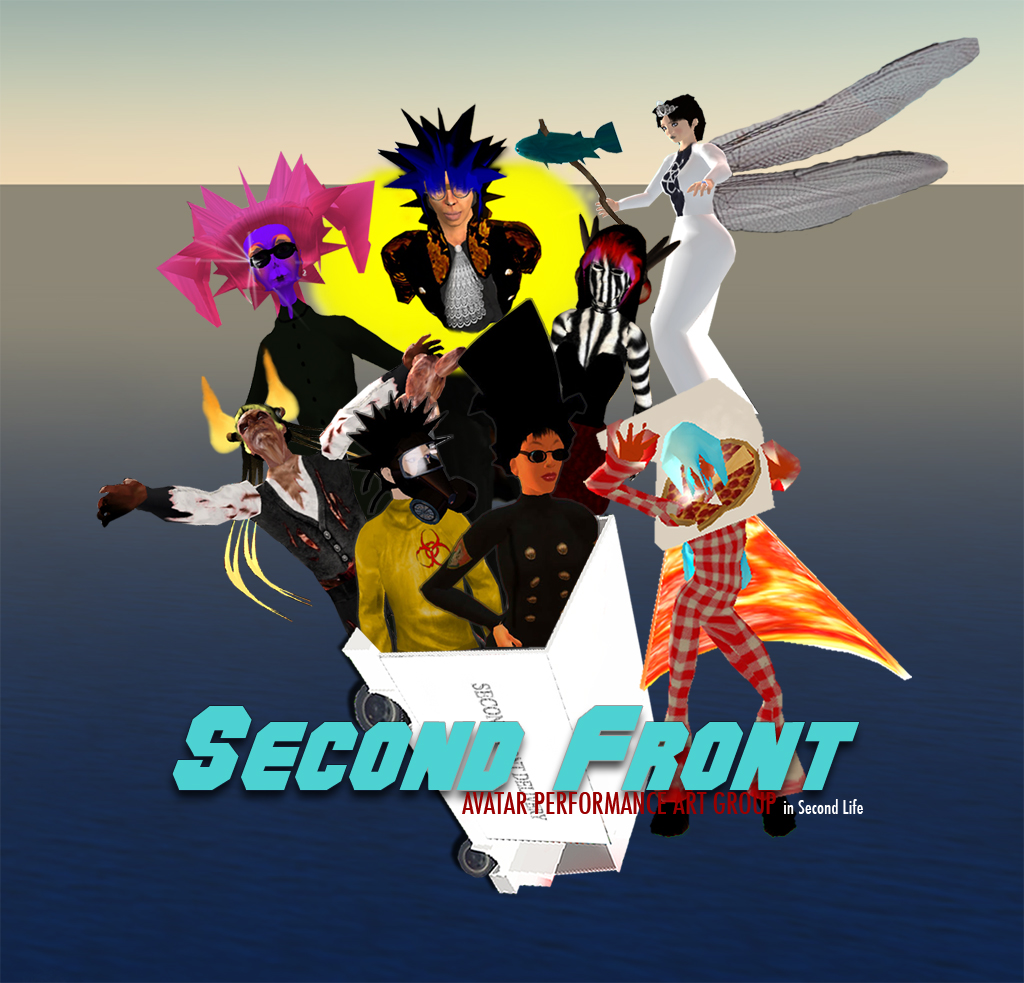
Research Critique: Second Front
Second Front, founded by a seven member group in 2006, is the first performance art group in the virtual world of Second Life. The members are Gazira Babeli (Italy), Yael Gilks (London), Bibbe Hansen (New York), Doug Jarvis (Victoria), Scott Kildall (San Francisco), Patrick Lichty (Chicago) and Liz Solo (St. Johns).
They are influenced by Dada, Fluxus, Futurist Syntesi, contemporary performance artists where they challenge traditional performance art and bring it into the virtual world.
One of their works, Grand Theft Avatar(2008) is a live performance by Second Front in Second Life. In this virtual world they have their own currency, Lindens, their own laws, rules and systems where it allows people to live in a virtual world. They robbed the Linden Treasury, disguised themselves as different characters and do all sorts of crazy acts to flee from the bank. Grand Theft Avatar challenges the role of traditional game structure. Also they questioned game strategies, the authenticity of currency, rules and lifestyle to Second Life.
- Grand Theft Avatar. Second Front performance. secondfront.org.
Grand Theft Avatar by Second Front performing in Second Life. (above) Credits: http://www.secondfront.org/Performances/Grand_Theft_Avatar.html
Grand Theft Avatar by Second Front, directed by Scott Kildall. (above) Credits: Patrick M Lichty (2017), https://youtu.be/RoHctMuI_HU.
Through the work done by Second Front, I am impressed and fascinated by their idea of a performance art. I have always thought that performance art must involve physical people but instead they used their own personal avatars. It brings a new experience and approach of how performance art could be further explored into. From the reading of their interview, I really liked how they bring gaming environment into their performance and how they make the performance a success despite the difficulties. They combined different areas together where virtual space through gaming environment and creating an avatar (making ourselves virtual instead of showing ourselves through a screen), and performance art which breaks the traditional conventions of one to many but creating a collective narrative performance art (many to many).
“By engaging the contrived space of an online gaming environment the challenges to perform are exaggerated by the parameters that persist as the interface with the context, the others members of the group, audiences and the templates of performance as an art medium.”
A leap into the void: interview with Second Front, TRAN SPIRE a.k.a Doug Jarvis.
Performance art in their context could be both physical where they broadcast to people viewing it and virtually where they are the ones doing a live broadcast of ‘themselves’ a.k.a their avatars. In this way, it is bring the first and second space together to make the third space exist and create a collective narrative together. I would imagine myself as an avatar roaming around the Second Life world and being part of the narrative with the other players and also showing it via Live at different places. It just blows my mind of how creative they are in pushing the boundaries of performance art and making it something new.
“…but in order for VR to produce meaning that breaks from the real and from past artistic social practices, and to become a medium that produces singular works, the binary of the real vs
virtual must be dismantled. Only then, will we be able to look at VR not as a simulation of the real, but as a simulation of itself.”A leap into the void: interview with Second Front, ALISE IBORG.
The current trend of technology is Virtual Reality (VR) where many games are exploring and/ or tapping into this resource. From the interview, the meaning of VR to incorporate into performance is by the combination of real and virtual. It is something that is happening now where the boundaries of both are blurred off. It is quite scary to think about how we would be more comfortable living in a virtual world and how we live our lives are based on the virtual world we have created. At the same time, it is quite interesting to incorporate both aspects into art. Elaine Warren, Los Angeles Herald Examiner, once said “A visionary premise … the lines between imagination and reality were blurred almost to distinction” and here we have the exact same thing said.
I could see that the Grand Theft Avatar performance could be another way of exploring the upcoming final project my group is working on. Each member could be portrayed as different avatars playing different roles. It is a brand new way of creating a live broadcast.
Overall I really liked this performance or Live broadcasting using avatar-based which makes me think of the different possibilities I could venture into when creating performance art or collective narrative with the use of first, second and third space. The artists have a common vision despite being in different places. Kit Galloway and Sherrie Rabinowitz mentioned “…create a performance place with no geographical boundaries…” which is now being practiced by Second Front.

Research Critique: Jennicam
The idea started off with a friend joking about using the camera Jennifer Ringley bought to update her website to do a FishBowl cam of a person which pilot the JenniCAM. It started off as still images of her daily life from her webcam to her website where her friends was her main audiences in 1996. It later progress to become a real-time video as the technology evolved. JenniCAM was a worldwide phenomenon for seven years. During this period, she practically lived in front of the camera where she did all the things people would do in their personal life for 24/7. The project was not clear whether it was performance or showcasing every single details of her life. In 2003, she announced that she was shutting her website down since the audience started to die down and on 31 December it was completely gone. From then on Jennifer was practically uncontactable and there seems to have no information of JenniCAM or herself.
Jennifer Ringley started the JenniCAM when she was 19 years old. She was the first artist/ designer/ performer to broadcast her life in front of her Webcam.
JenniCAM is a inspirational and revolutionary real-time broadcast project as I was reading and researching on this. Who would have thought of showcasing their own personal life activities in the 90s where the internet was just starting to take flight or even to think of something extraordinary which was to broadcast live or even show still images of their lives, it was none other than Jennifer Ringley. This project attracted millions of viewers and subscribers where they just watched her life 24/7. I was shocked that so many people would actually watch this. I guess this was something that was fresh since she took a whole new approach to live broadcast where it was more common to see news live during the 90s rather than oneself personal life.
What impressed me the most about JenniCAM was the courageous act of the 19 years old Jennifer. The act of giving up what I call personal space or life in Jennifer’s case she is willing to expose it to everyone. It would never cross my mind to show everyone how I would lead my personal life as I felt that it was intruding my privacy.
“Because I don’t feel I’m giving up my privacy. Just because people can see me doesn’t mean it affects me – I’m still alone in my room, no matter what.”
Jennifer Ringley. JenniCAM. Credits: http://web.archive.org/web/19980124154026/http://www.jennicam.org:80/faq/general.html
In the quote above, she felt that this project does not give up her privacy means that she viewed it in a different light. I found it interesting because her idea of privacy seems that when people are in the same environment as her and watching her then it means giving up her privacy when millions of people are watching her via the internet.
In JenniCAM the interaction with the audience is through an email where they could make suggestions of what they would want to see or give her feedback of the project. Jennifer would read it and may reply to the emails sent to her but other than that there seems to be not much interaction with the audience via live. I am curious on how the interaction would be like if the technology had allowed the interaction be both ways. But she did change the way of live broadcasting in the present age.
TV show talking about JenniCAM with Jennifer Ringley and David Letterman.
There are many live apps such as Twitter, Facebook where people around the world show their everyday lives. In Korea, many celebrities use the social media: Instagram and V Live to communicate with their fans and to share their personal life. They can see comments by their fans and talk to them via live without having to type back to them. It creates an interaction with the celebrities and fans around the world.

- A screenshot from V Live App, where Korean celebrities talk about their blood types and other personal details with fans. Credits https://www.techinasia.com/video-streaming-apps-insights.
In China, millions are also broadcasting their personal lives through broadcasting apps ever since the popularity of it. A 19 years old student Nic Li spends 3 to 4 hours streaming online where she talks and sings for her viewers and feels a sense of satisfaction. She likes attention from her audience since she feels lonely and this could be a way to kill boredom and create conversations.
“Sometimes I feel lonely and want to talk to people,” she says. “It feels nice when viewers are paying attention to me.”
Nic Li, 19, China student.
Credits: https://www.forbes.com/sites/ywang/2016/06/02/in-china-millions-are-broadcasting-their-personal-lives-online-including-the-countrys-richest-man/#28a176781a0c

- Online web performer Wang Weiying, 18, broadcasts a live stream from her smartphone in a cafe in Beijing in February. (AP Photo/Mark Schiefelbein). Credits https://www.forbes.com/sites/ywang/2016/06/02/in-china-millions-are-broadcasting-their-personal-lives-online-including-the-countrys-richest-man/#28a176781a0c
Through one person starting the trend of broadcasting herself live which created an uproar of streaming apps around the world where people openly share their personal life or even chatting with people. If Jennifer Ringley did not start JenniCAM we would not know of such platform of live broadcasting and probably we would not have Facebook Live or other streaming apps. Personally I am impressed by her ongoing live broadcast for 7 years even as technology evolved she tried to keep up with it. Her openness to showcase her life from sleeping to eating to being nude in front of the camera made me respect her courage as I would not been able to do it. She has inspired me to be more open to broadcasting about my life but there are some restrictions I would take such as being nude in front of the camera.
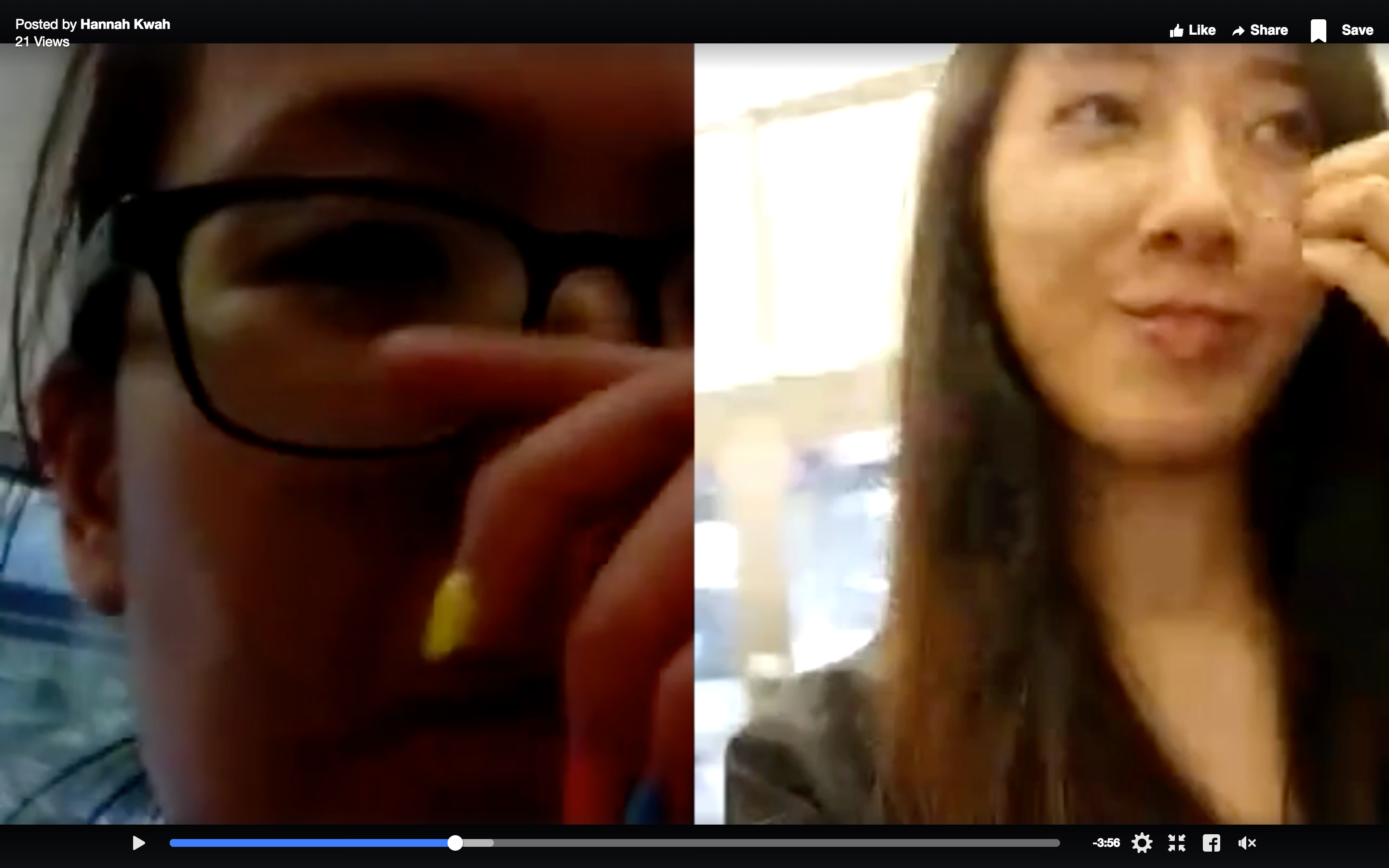
Co-Broadcasting Experiment
Co-Broadcasting Experiment
Before the broadcast, I was quite shocked that we could do a split screen via Facebook Live. I was excited that we could do that since it tied in with the final project my group was about to embark.
When the live broadcast was starting, I was facing some difficulties with the internet connection in school (as usual). I had to seek help from my classmates on how to do the split screen after inviting my partner, Joan. After struggling for some time, I finally got the split to work and the both of us was very excited about it.
It was interesting that we could hear each other from both side but only the person who invited the other person could see both sides. The other person could only hear the invited person voice but could not see the face. The only problem was that both sides could not see each other.
Overall, it was quite an experience where we could co broadcast without finding other means to see each other face-to-face. I enjoyed the experience.
Co-broadcasting
Posted by Hannah Kwah on Thursday, 12 October 2017
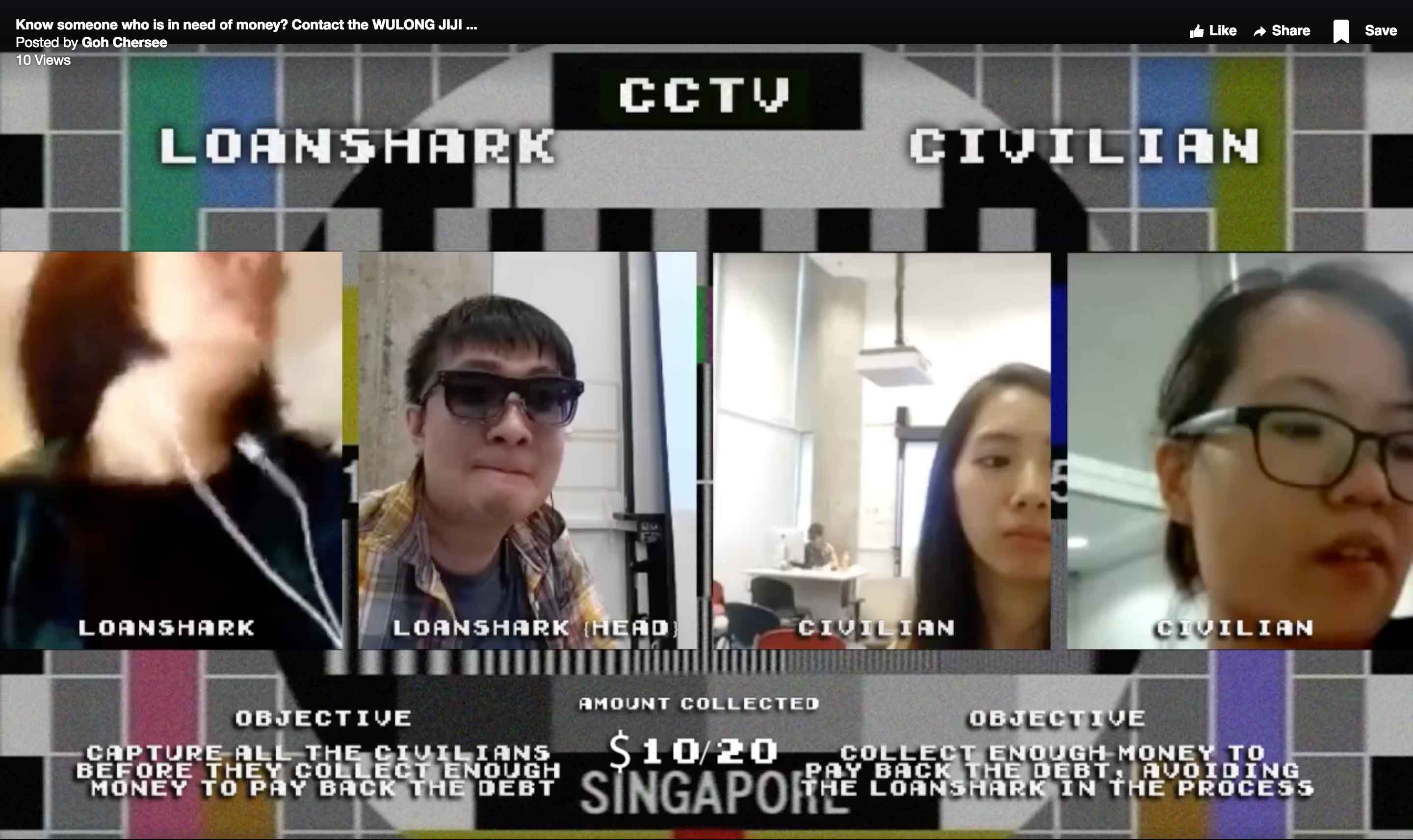
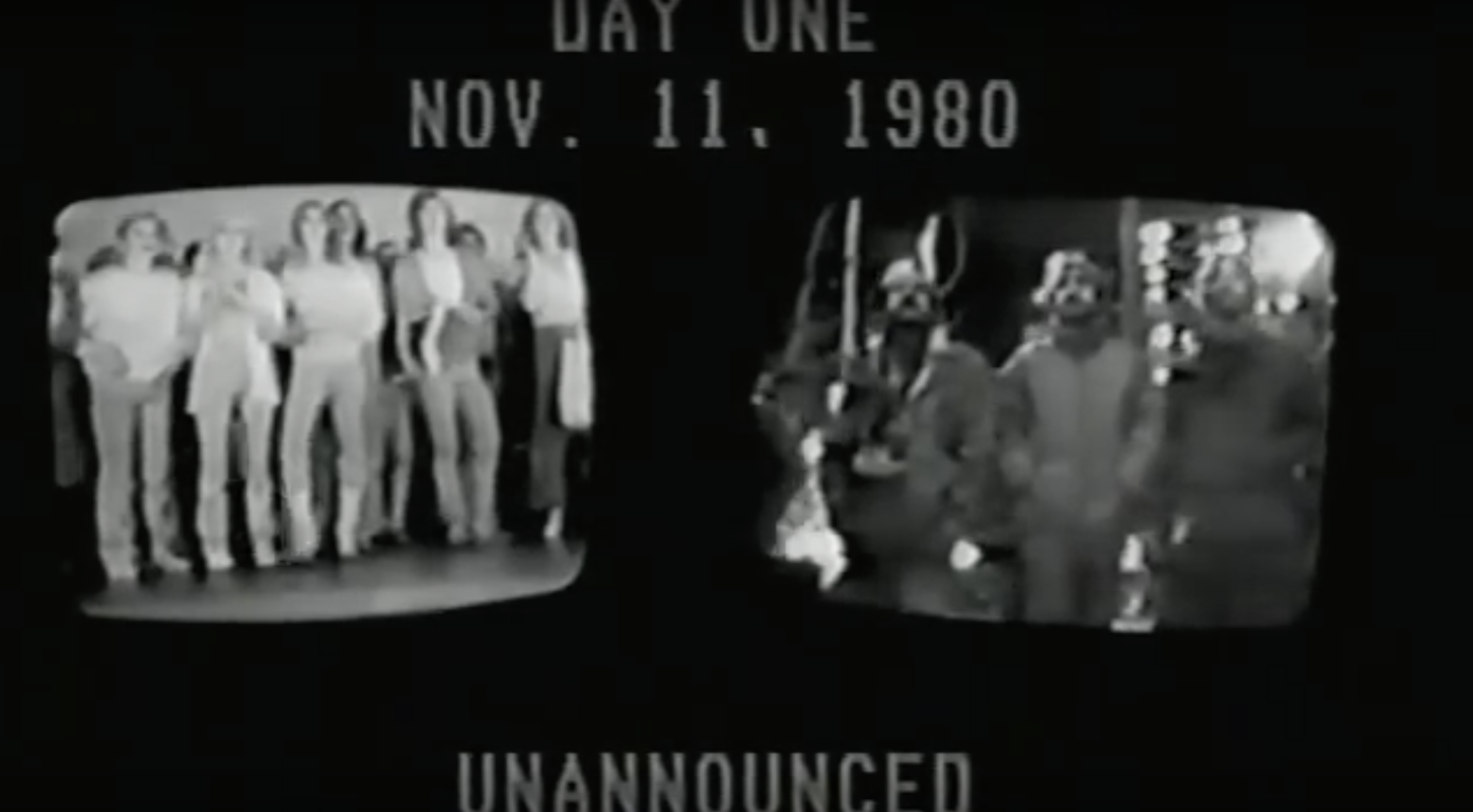







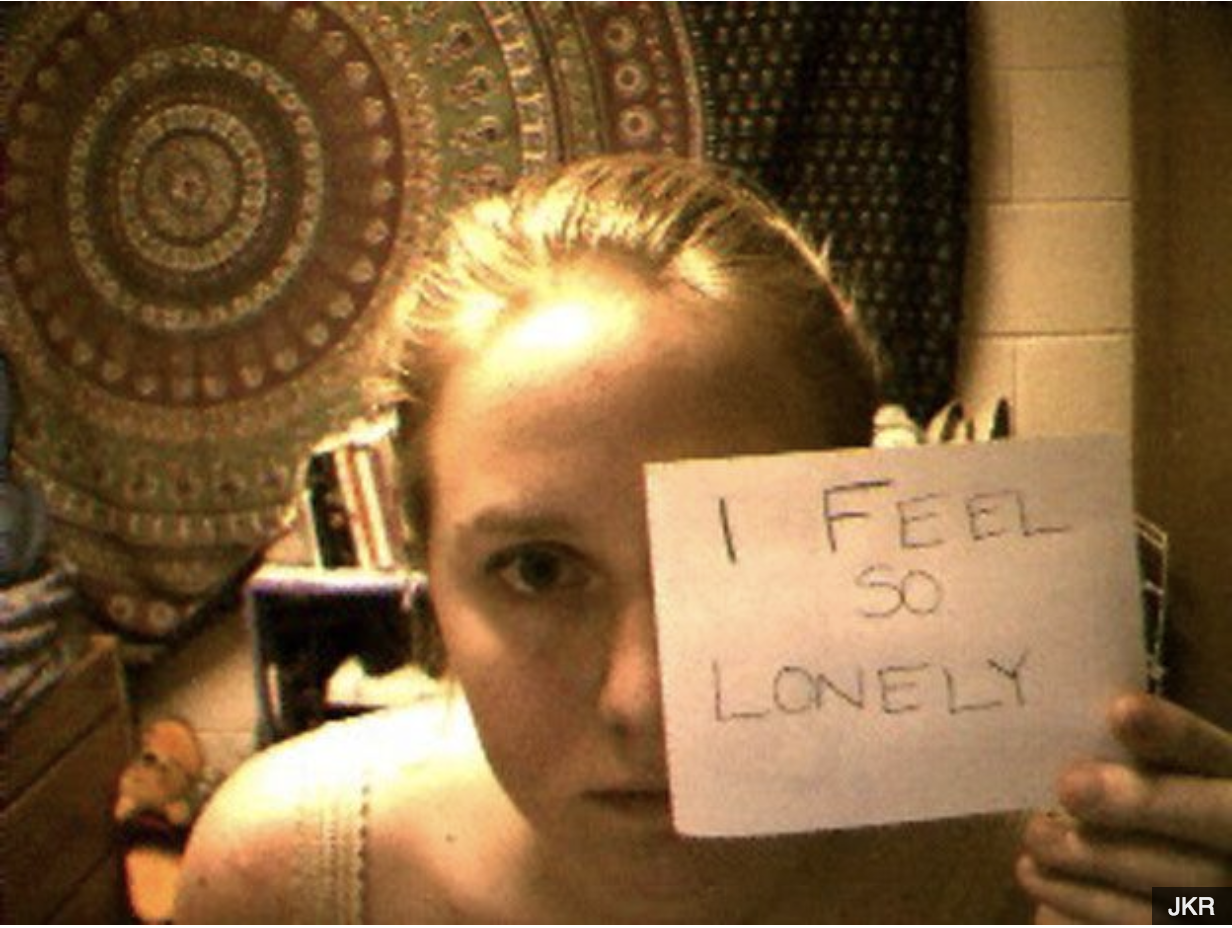
Recent Comments